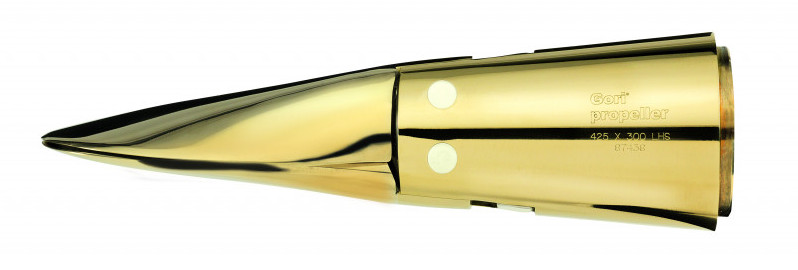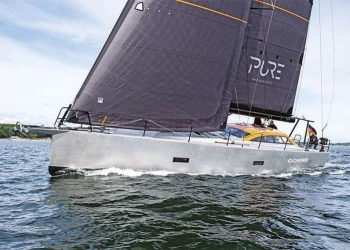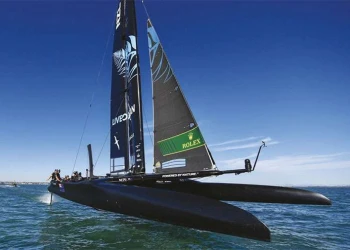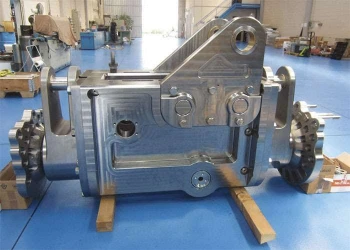
Gori’s folding propeller designs, for racing and cruising yachts large and small, have stood the test of time and are still state of the art today
The original Gori folding propeller is still winning awards
The prototype Gori folding propeller was informed by a range of influences, from engineers, from a manufacturer of specialist paints and a designer from iconic audio group Bang & Olufsen. So it’s no wonder that approaching its 50th anniversary the original concept is still winning awards
The first real attempt to design a folding propeller with synchronised blades was made in Germany in the early 1970s. Shortly after the news broke, the phone rang at the office of the inventor, Mr. Menke. The man on the other end of the line introduced himself as Niels Oluf Ehrenskjöld from Denmark, who ran a company called Gori.
At the time, Ehrenskjöld’s company produced paint and wood protection for houses and is still a major player in the construction industry today. But he also had a maritime subsidiary, Gori Marine A/S, an agent for Nautor’s Swan in Denmark, Germany and Switzerland. Ehrenskjöld told Menke that he had heard about this new propeller that could be folded under sail, and he thought it might be a good idea to be an agent for the new invention.
It turned out to be a very good idea. Soon Ehrenskjöld took over the entire project and developed an improved version. A collaboration was established between Gori and the Danish Maritime Institute. The Bang & Olufsen designer David Lewis was also involved. Based on the original German design, the team developed a new two-bladed folding propeller that changed the history of sailboat propellers.
In 1976, Gori's two-bladed folding propeller won the Danish ID award for outstanding industrial design. The propeller has not changed since, and is still in production today, recognised as one of the most popular folding propellers ever introduced to the sailing community. And it has proven to stand the test of time: In 2007, the German sailing magazine Segeln carried out a tank test comparing folding propellers. More than 30 years after its launch, Gori's two-bladed folding propeller still came out as the most efficient.
Today, the 50th anniversary is within sight and Gori Propeller is a brand known to virtually every sailor on the planet. New products have appeared over the years but the list of products on Gori's website is still short. They rarely introduce a new product – but when they do, it tends not only to win awards and large market shares, but also to remain in production for decades.

After the success of the first product, the next big project was the Gori two-bladed racing propeller. In the early 1990s when the Whitbread Round the World Race was peaking, Gori was approached by Silette Sonic, a British manufacturer of saildrives. They wanted to supply a propeller to a Whitbread Race competitor with as little water resistance as possible. Gori took on the development work and the result was the Gori Racing Propeller – still today the propeller of choice on most professional racing boats. Most of the newer one design classes, such as Cape 31, Melges 37, ClubSwan 43 and ClubSwan 50, are supplied with Gori Racing propellers. For the recent round-the-world race in giant trimarans, Ultim Challenge Brest, all participants used Gori. And for the upcoming Vendée Globe, 95 per cent of the Imoca fleet will be equipped with Gori Racing.

The development in the cruising market up through the nineties went in the direction of larger boats with larger engines. ‘Bigger engines need bigger propellers’, says Lars Østergaard, senior vice president for sales at Gori Propeller. ‘You can compare a propeller with the tyres on a car: A car with a big engine needs wide tyres to transfer all that engine power to the asphalt. The same applies to a propeller: with a larger engine, you need a larger propeller blade surface area. And there is a limit to how much area you can get with only two blades. That was the background for developing a three-bladed folding propeller, launched in 1994 and winner of the METS DAME Award in the same year. It quickly became a bestseller and today it is our main product. We sell it primarily to cruising boats.’
‘Product tests against the leading competing brands have shown over decades that Gori's three-bladed folding propeller continues to be the most efficient’, says Østergaard. ‘It differs quite significantly from other three-bladed folding propellers. The Gori propeller operates with the same pitch in forward and reverse, and the blades turn 180 degrees, which gives the boat excellent manoeuvrability. Safer and easier harbour manoeuvres are essential for cruisers. They want to be able to stop the boat efficiently and the Gori three-blade propeller delivers that feature better than any other product on the market. At the same time, it has lower resistance through the water – 1.4 newtons at six knots of boatspeed – than all competing three-blade folding propellers.’
The overdrive function is also an attractive feature: the three-bladed Gori propeller has two different forward pitches – normal and overdrive. ‘The function in overdrive can be compared with the fifth gear in a car’, says Østergaard, ‘a gear you use when you drive at good speed on the motorway with low revs and want good fuel economy. If you drive up a mountain side, you need to change gear to avoid choking the engine. The same is the case with overdrive: If you are in a counter current or large waves, you switch from overdrive to normal. What happens in overdrive is that the blades turn 180 degrees, just like in reverse, but the propeller keeps pushing forward. The increased boost now acts as a higher gear, resulting in a 20 per cent fuel saving. This means 20 per cent more nautical miles on the same amount of fuel. And you don't need to look at our numbers. Hallberg Rassy, one of the yards using Gori on all their models, carries out thorough tests on all their products, and their numbers show the same result.’
Another unique feature is the ability to prevent automatic rotation. Other folding propellers tend to keep rotating under sail when the propeller is folded. This does not happen with Gori's three-bladed model: when fully folded, the star-shaped blade configuration creates a water pressure that keeps the propeller folded and prevents it from rotating.
The model is particularly popular among long-distance sailors: Gori claims that eight out of 10 boats crossing the Atlantic have a Gori three-bladed folding propeller. Although the operation of the two modes is fairly straightforward (basically you put the engine in reverse to change gear), there is also a single pitch version available, for sailors who want simpler operation.
‘A few simple routines will ensure that you get the most out of your folding propeller’, says Østergaard. ‘Maintenance is easy, but still essential to do. In short, the propeller must be kept clean and when the boat is on shore it must be rinsed, lubricated and supplied with a new anode. Also, most sailors know that a folding propeller has to stop rotating to fold completely. This is why the engine has to be put in reverse after the engine has been stopped. But not everyone is aware that this practice only works for engines with a mechanical gearbox or sail drive. For engines with a hydraulic gearbox, it is necessary to put the engine into reverse briefly – just a few seconds – before putting it into neutral and stop. In short, the shaft has to stop before the engine stops. Otherwise the propeller may still be slightly open, causing the shaft to continue rotating.
‘When we calculate the correct propeller for a customer, we always optimise first on the diameter, since that is what primarily provides the efficiency in a displacement boat. At the same time, we aim for a pitch between 65 and 83 per cent, which has proven to be optimal. At an engine size of around 35hp you begin to need a larger blade area than can reasonably be obtained with two blades. So from there on we usually recommend a three-bladed propeller. When we reach approximately 150hp, four blades are needed. And with really big engines, around 400hp, it doesn't really make sense to have a mechanical folding propeller any more. For these purposes, we refer to our sister company, Hundested Propeller. They make large propellers with controllable pitch’.
Gori propellers are still produced in Denmark, where the company’s HQ is in Haderslev. Control of materials, design, production and quality control are done in house. A €1 million investment in CNC machines and technology means that new products can be developed with even greater precision.
Since the days of Niels Oluf Ehrenskjöld the company has changed hands a few times and since 2015 Gori Propeller has been part of the BSI Marine Equipment Group. BSI is today one of the world's largest manufacturers of equipment for the boating industry: rigging, propellers, steering systems, blocks, hatches and bow thrusters are the main product types, all of which are produced by independent companies under their own brands. In addition to Gori Propeller, BSI today owns Hundested Propeller, Jefa Steering, Easy, Moonlight Portlights and Hatches, Ocean Marine Systems (OMS) and OYS.







